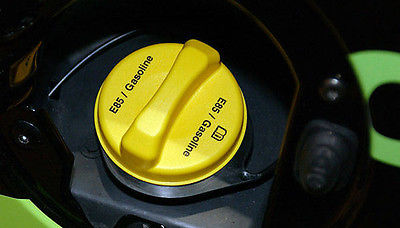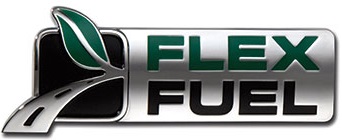Automakers Complain, but CAFE Loopholes Make Standards Easier to Meet
With gasoline prices averaging $2 per gallon, automakers are pushing back hard on U.S. fuel economy standards.

Last year was the biggest year ever for the U.S. auto industry with 17.5 million total vehicle sales nationwide. Trucks, SUVs, and crossovers led the charge with a 13% increase compared to 2014.
The one problem with selling all these gas guzzlers is that it makes it harder to meet fuel economy standards. U.S. Corporate Average Fuel Economy (CAFE) standards have been around for a long time, but the new “super-size” version introduced in 2012 mandates a steep climb in fuel economy each year until 2025.
Back in 2012 when the Obama Administration announced the new standards, gasoline prices were $4 per gallon and Americans were buying smaller, more fuel-efficient vehicles. Sales were increasing rapidly for the Chevrolet Volt, Tesla Model S, and other electric vehicles, and there was great optimism about reducing the carbon-intensity of the U.S. transportation sector.
Fast forward to 2016, and the automakers can’t believe they ever agreed to this. The new CAFE rules are scheduled to be reviewed this summer, and automakers are pushing back hard, seeking adjustments that would weaken the standards to reflect this new reality of cheap gasoline.
In pleading their case, one of the automakers’ favorite approaches is to try to shift the focus to consumers. “One of the areas that needs to be addressed is consumer demand,” recently argued Gloria Bergquist, spokeswoman from the Alliance of Automobile Manufacturers, “Automakers can build models that are extremely fuel-efficient, but they can’t control sales.”
But, of course, automakers can control sales. In the short-run, automakers can adjust prices. And in the long-run, automakers can design new fuel-efficient vehicles that Americans want to buy. Nobody expected this to happen by itself. The whole rationale behind CAFE is that there are externalities associated with gasoline consumption. If we thought consumers were going to perfectly internalize these externalities, then we wouldn’t need CAFE in the first place.
What Ms. Bergquist probably meant to say instead is that $2 gasoline makes it harder to get consumers to switch. This is certainly true. Cheap gasoline provides huge benefits to U.S. consumers, but it also leads drivers to prefer larger, more powerful vehicles.
Fortunately for the automakers – though not for the environment – there is a built-in mechanism that relaxes the standard when consumers choose larger vehicles. The new standards are “footprint” based so that the fuel economy target for each vehicle depends on its overall size. Larger vehicles have less stringent targets.

The standards are also more generous for trucks than cars. Most of the best-selling vehicles are “trucks” from a CAFE perspective including, of course, pickup trucks, but also SUVs, crossovers, and minivans. And as Americans switch from “cars” to “trucks” this makes it easier for automakers to comply with CAFE.
The real but more subtle challenge for manufacturers is that cheap gasoline makes consumers prefer more powerful engines (for a given footprint) and makes them less willing to buy EVs and hybrids. The automakers can adjust their prices to sell lower horsepower engines and more EV’s and hybrids, but this reduces profits.
There is one more loophole, however, to help soften blow. And it is a big one. My colleague Jim Sallee and former student Soren Anderson worked on this topic several years ago (here), but until I looked at it again, I had no idea how large this loophole was, nor had I known that the loophole would last so long after being initially introduced in 1993.
I’m talking about flex-fuel vehicles. Over two million flex-fuel vehicles are sold each year in the United States. These vehicles can run on E85 (a blend of 85% ethanol and 15% gasoline), but in practice, most end up running on gasoline and many sales of flex-fuel vehicles occur in parts of the country where there is limited E85 availability.

Under CAFE, however, these vehicles have a near-magical property. They are assumed to be operated 50% using E85 and 50% with gasoline — a very optimistic assumption. But even more optimistic, each gallon of E85 is assumed to have the carbon content of only 0.15 gallons of gasoline. This is, the ethanol component of E85 is assumed to be zero carbon. It is notoriously difficult to quantify the lifetime carbon impacts of biofuels but most studies find that, at best, ethanol is only marginally less carbon-intensive than gasoline. As a result of these overly generous assumptions, flex-fuel vehicles like the GMC Terrain end up being treated by CAFE as if they were extremely fuel-efficient.

Not surprisingly, manufacturers have been producing flex-fuel vehicles like crazy. There are today more than 100 different models of flex-fuel vehicles for sale in the United States (who knew?). And while you used to always see a “flex fuel” sticker on the back, many flex-fuel vehicles today aren’t even identified. You might be driving one and not even know it.
Thankfully, the flex-fuel loophole ended with model year 2015. These credits were so lucrative, however, that many manufacturers are now sitting on large stores of surplus credits. Under CAFE rules these credits can be “banked” until 2021, ensuring that the legacy of this loophole will live on, allowing manufacturers to produce lower-MPG vehicles for years to come.

So let’s not feel too sorry for the automakers. Yes, the CAFE screws are beginning to tighten, but the automakers’ situation is not nearly as dire as they would have us believe.
Keep up with Energy Institute blogs, research, and events on Twitter @energyathaas.
Suggested citation: Davis, Lucas. “Automakers Complain, but CAFE Loopholes Make Standards Easier to Meet” Energy Institute Blog, UC Berkeley, April 11, 2016,
https://energyathaas.wordpress.com/2016/04/11/automakers-complain-but-cafe-loopholes-make-standards-easier-to-meet/
Categories
Lucas Davis View All
Lucas Davis is the Jeffrey A. Jacobs Distinguished Professor in Business and Technology at the Haas School of Business at the University of California, Berkeley. He is a Faculty Affiliate at the Energy Institute at Haas, a coeditor at the American Economic Journal: Economic Policy, and a Research Associate at the National Bureau of Economic Research. He received a BA from Amherst College and a PhD in Economics from the University of Wisconsin. His research focuses on energy and environmental markets, and in particular, on electricity and natural gas regulation, pricing in competitive and non-competitive markets, and the economic and business impacts of environmental policy.

This analysis shows how much impact the flex-fuel credits and other CAFE credits/loopholes has had.
http://pubs.acs.org/doi/abs/10.1021/acs.est.5b02842
Alternative Fuel Vehicle Adoption Increases Fleet Gasoline Consumption and Greenhouse Gas Emissions under United States Corporate Average Fuel Economy Policy and Greenhouse Gas Emissions Standards
Alan Jenn, Inês M. L. Azevedo, and Jeremy J. Michalek*
Carnegie Mellon University, 5000 Forbes Avenue, Pittsburgh, Pennsylvania 15213, United States
Environ. Sci. Technol., 2016, 50 (5), pp 2165–2174
DOI: 10.1021/acs.est.5b02842
I have the following points to add to the excellent debate here on this subject:
• According to NHTSA and EPA, the standards are expected over the period 2017 – 25 to save 4 billion bbl of oil and reduce GHG emissions by 2 billion tons over the lifetime of the vehicles produced in the same period. They estimate net benefit to society as $ 326 – 451 billions.
• The price drop is upending the debate on fuel energy efficiency in place since the 1970’s from one based on energy savings and energy security to one that emphasizes speed, power and convenience. As a result, the fuel economy standards may deliver only half to two-thirds of the anticipated reduction in fuel consumption.
• The impact of the oil drop is also directly impacting: stranded capital on the part of all the auto, air, sea, and land transportation industries, as well as the end consumer. The standards don’t address the potential of substantially lower long term fuel prices and hence the potential of stranded capital on the part of all.
• Energy and cost savings: The justification for the new CAFE standards relies substantially on a calculation of economic benefits to consumers. The fuel efficiency objective to a large extent is directly threatened by the drop in oil price with the payback period on energy saving car purchases doubling.
• Speed and distance travelled: Fuel consumption rises with the third power of speed. Consumers are justifiably driving faster and longer distances in response to lower prices.
• Inter-vehicle substitution: The fuel economy regulations specify separate standards for cars and light trucks as pointed out here with stricter standards for cars and more generous ones for trucks which is driving the shift to trucks and larger vehicle purchases. Consumers have responded to the drop in prices by opting to buy more trucks and fewer cars, lowering the economy-wide fuel savings compared with the original projections.
• Transport system: The emphasis within the entire transport system is shifting from minimizing fuel cost to maximizing speed and convenience. Cheap fuel is stimulating a surge in delivery services and the focus on super-fast deliveries. Delivery services are the fastest growing part of the freight network and are expected to provide most of the demand growth over the next decade. More tankers and container ships are taking the long way round Africa via the Cape rather than transiting the Suez Canal to save on canal fees.
• Demand for oil: The full impact of the new equipment purchasing and operational decisions is supporting faster growth in oil demand in a replay of the late 1980s and 1990s.
• Given the above, a significant review of fuel efficiency and CAFE standards need to be conducted in light of lower oil prices. Such a review need to take in consideration: review of fuel efficiency objectives, consumer preferences for vehicle size and performance, calculation of economic benefits to consumers, stranded capital, and the growth and stability of the auto and transportation industry in the new price environment.
Lucas – thank you for a very interesting article. I appreciate being able to purchase a larger, heavier vehicle. My Hi-tech [Google-like] Acura MDX [a mid-sized SUV] protects my older, brittler bones [Osteoporosis/-pena]. Part of the hi-tech is switching from 6 to 3 cylinders when cruising, whether at higher or lower speeds. This gives 33 mgh on the highway and 22 in the city [Davis]. This beats hybrids’ mgh on the highway, but not in the city. LKAS keep me centered in the lane, and the ACC [adaptive cruise control] keeps me a safe distance from the vehicle ahead, or brakes if someone cuts in front. I do not plan to nod off for a few seconds, but it has happened, and the vehicle makes that safer! I get beeped if my hand, or even a finger is not on the steering wheel for about 5 secs.
That also explains why Nissan and Fiat are giving ‘deals’ on their EVs.
Great post. I’ve always wondered how bad CAFE was (just tweeted the wiki article… it’s worse than you say!). What drive me crazy is that CAFE is not weighted by sales. Holy cow, you only need a 40mpg car in your fleet to bring the 10mpg car up to 25 mpg CAFE? (I know it’s more complex than that). No wonder corps are selling 10x more gas guzzlers!
Good observations about the loopholes. I’d be interested in knowing the implications for CO2 emissions. On the other hand, cheap gasoline is driving down the price of hybrid and electric vehicles, many are available, and I just bought a used plug-in hybrid. Also, how will the 300,000+ Tesla Model 3’s, coming in 2017-2018, change emission projections compared to expectations under CAFE.